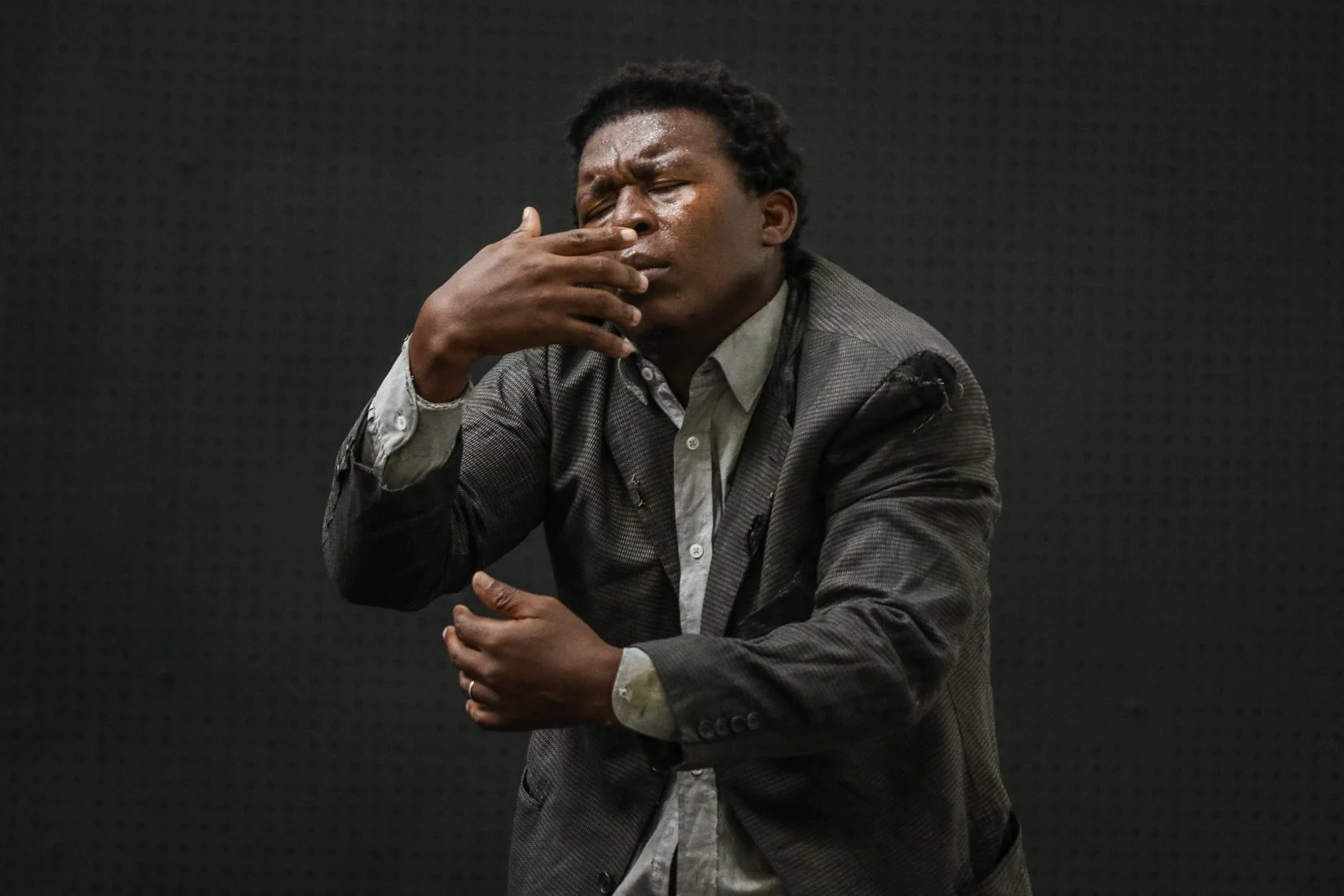FOOTNOTES
Sound, rhythm, and the inherent language of the body are used to tell a tale of land, governance, and power in the 9-minute performance of Footnotes.
In Footnotes, a team of dancers and musicians equipped with typewriters and percussive instruments begins to question the nature of their being and their work, caught between modes of survival and instruction.
Kitted out in white-collar uniforms, they type out orders, eviction notices, and instructions for removal. They affect great change and disruption, all through the 26 letters of a typewriter. An abrupt about-face, and a striking shift in tone takes place. Choice soundbites – media interviews with displaced peoples – lends a searing reality to the otherwise surreal nature of the performance and activates the shadow-side of the performers. Suddenly they are outfitted in red overalls, the uniform of eviction. There is a rampant physicality, dance as chaos and mania.
While Footnotes is largely a physical and musical performance, the narrative underpinning is clear: It is an exploration of the power of words, of text, to radically shift and impact lives. It is a work that explores the power of language, instruction, and the body, as well as the ensuing narratives of disruption and displacement.
– David Mann
CREDITS:
CONCEPTUALISER & DIRECTOR | Vusi Mdoyi
PERFORMERS | Muzi Shili, Volley Nchabeleng, Micca Manganye & Thabo Rapoo
COSTUME DESIGNERS | SO Academy Costume Mentees
TEA & BAE
A two-hander that favours synchronised choreography over the spoken word, Tea & Bae explores storytelling as a form of bonding and intimacy.
Tea becomes symbolic in this short, sharp staged work. A freshly, brewed batch of tea enjoyed at a table-turned-stage serves as an opportunity to connect, gossip, bond, exchange secrets, hopes, fears and desires.
Movement reigns supreme and serves as the primary driver for these intimate narratives. Rich stories are found in the crook of an elbow, the tentative sip, or the stolen glance over the rim of the cup, while a barely contained smile hints at a story that’s steeped in its own private history.
The performance is also one that is charged with a spellbinding tension. It is a work of fragile things handled excitedly, whimsically, coyly. It is an intimate musing on love and human connection as both fragile and precious.
– David Mann
CREDITS:
CONCEPTUALISERS, DIRECTORS & PERFORMERS | Molebogeng Phiri & Kaldi Makutike
COSTUME DESIGNERS | SO Academy Costume Mentees
BOGOLOGOLO TALA
Vivid physicality, animality, and the pursuit of companionship converge in Bogologolo Tala, a work of sharp movement and physical theatre which employs the body as the primary means of storytelling.
A slow, deliberate, and corporeal march opens the stage and establishes the tone of the performance. Using only their bodies and a few carefully executed facial expressions, the characters of Bogologolo Tala leap, crawl, and dance across stage, vying for attention, fuelled by lust, love and a longing for partnership. Jealousy sparks outrage and a thundering of limbs on stage, while tender slow-dances hover in-between a state of bliss and the subtle humour of routinised courtship.
A smart and economic performance that forgoes music, spoken language, or detailed set, Bogologolo Tala spotlights the enduring nature of physicality and the inherent language and romance that drives the body in motion.
– David Mann
CREDITS:
PERFORMERS | Alfred Motlhapi, Elma Motloenya & Kaldi Makutike
DIRECTOR | Phala Ookeditse Phala
COSTUME DESIGNER | SO Academy Costume Mentees
THE DRESS
The Dress is a short and sobering play by Thabo Rapoo that serves as a reimagining of Can Themba’s The Suit.
The Dress begins where The Suit ends. The air is heavy with loss and grief. Rapoo enters and begins a lonely, mournful dance with the absent Matilda, who is represented on stage by a double bass that is never played.
The chair is another charged object. It functions as a site of memory, and serves as a tangible reminder of loss. Rapoo’s choreography is intimate and unsettling. Alone in his small world, surrounded only by reminders of his wife, he performs a dance with grief, he waltzes with regret.
All the while, Matilda – the double bass – remains on the ground. There is no sound or activity there. She is mute, she is gone.
– David Mann
CREDITS:
CONCEPTUALISER & PERFORMER | Thabo Rapoo
DIRECTOR | Phala Ookeditse Phala
COSTUME DESIGNERS | SO Academy Costume Mentees
SORRY/ASKIES!
Sorry/Askies! presents the innumerable forms and functions of a word we too-often employ in our daily lives.
Staged in the wake of a global pandemic, it feels now like a play from another time – this proximity to people, this crowdedness and human disarray. Performed by Thami Majela & Teresa Phuti Mojela, Sorry/Askies! is a swift and sharp work that plays with language and the body to the point of hilarity. The two characters get in each other’s space, poke and prod, conspire and provoke, communicating all the while with a single word and its various translations and meanings.
“Askies!” they say as they knock something to the ground. “Sorry?” they ask, looking for a space to sit down. It is through the myriad circumstances, tones, and intentions of this ‘sorry’ (as well as the occasional ‘chommie’ and ‘wena!’) that the play derives its relentless energy and appeal.
As it turns out, not even the audience is immune to the word. Towards the back of the audience, a phone rings and rings without being silenced. People murmur, turn their heads. As the noise goes on, distracting from the activity of the stage, the two turn to face the crowd, locating the source of the ringing. Without breaking character, they lean forward, stare the unlucky audience member down, and launch into a resounding and accusatory “SORRY!”
– David Mann
CREDITS:
CONCEPTUALISERS, DIRECTORS & PERFORMERS | Thami Majela & Teresa Phuti Mojela
COSTUME DESIGNERS | SO Academy Costume Mentees




